
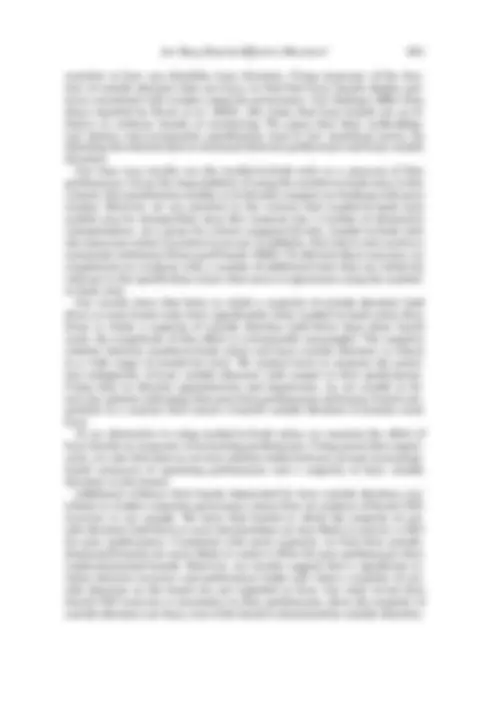
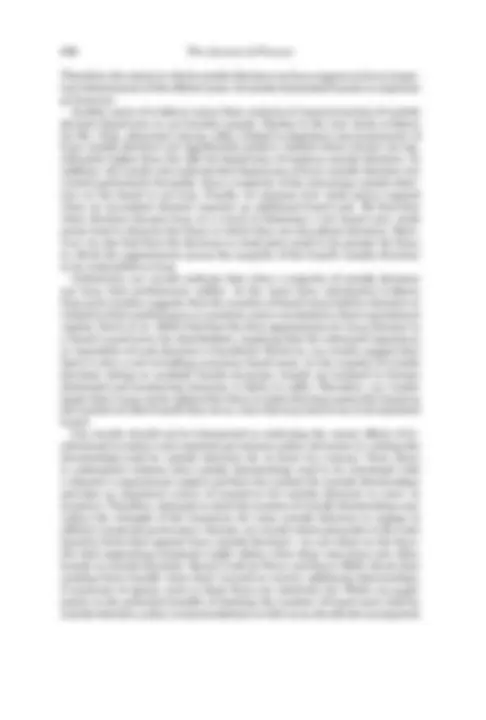
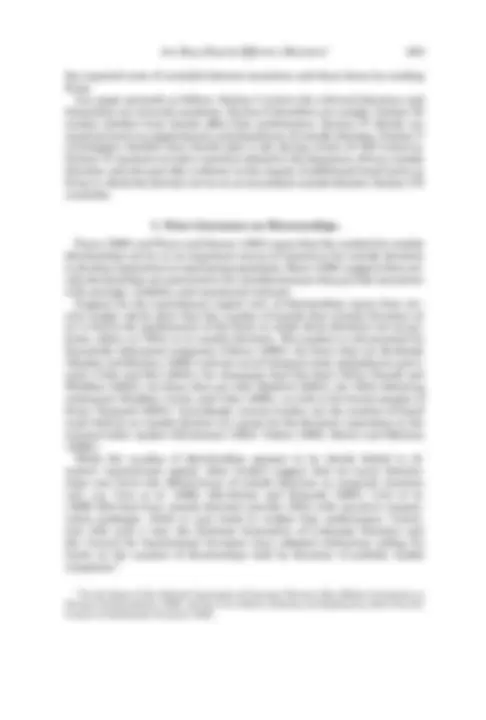

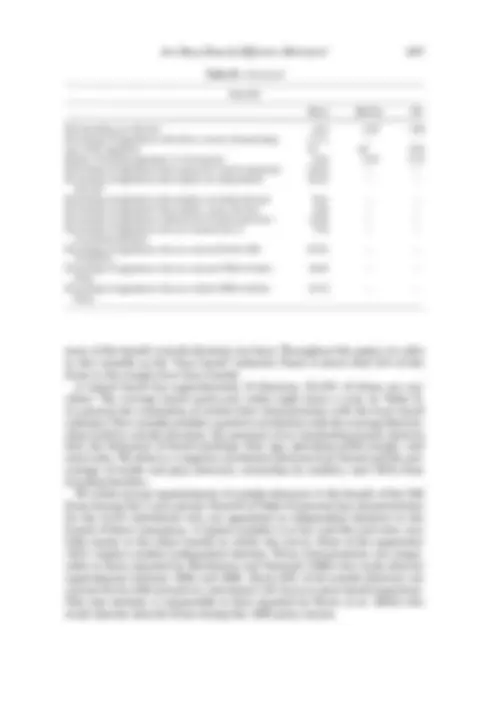
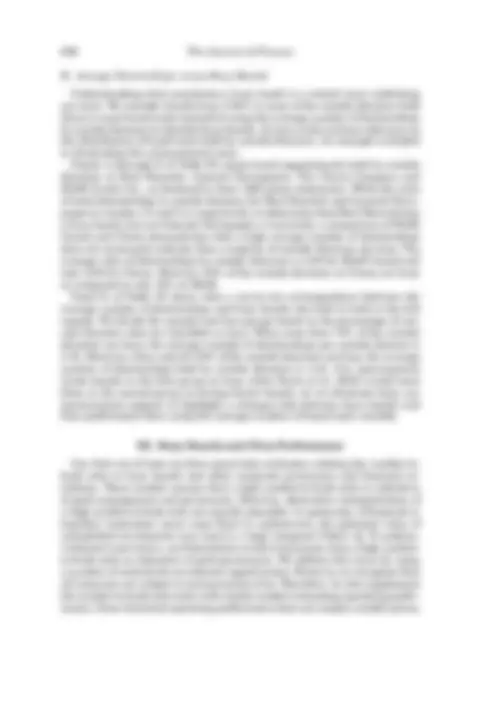

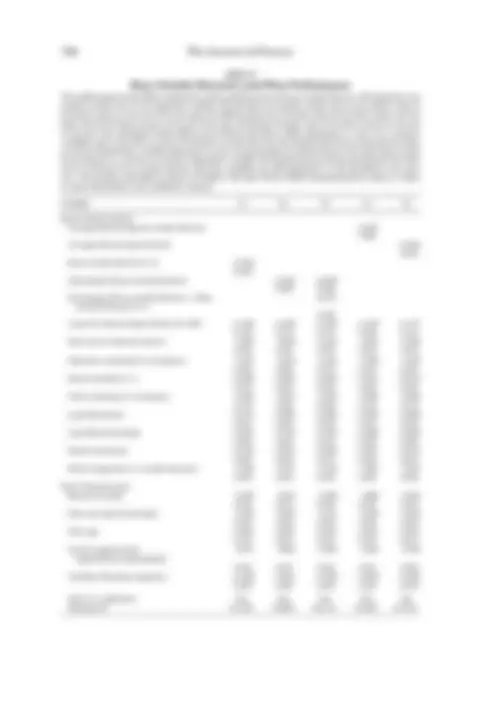
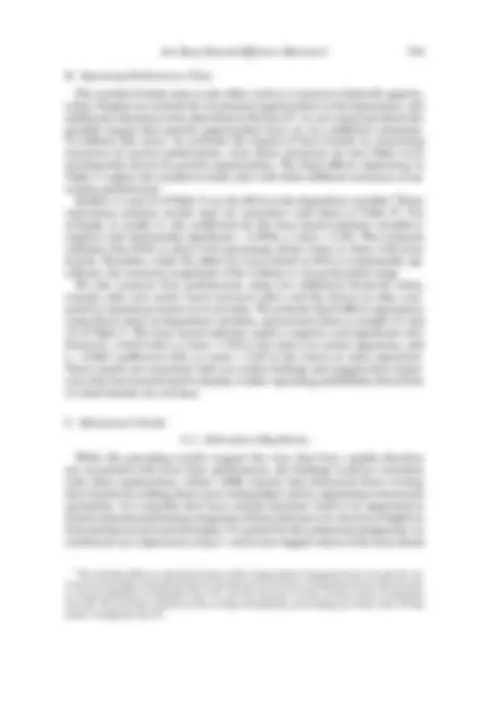
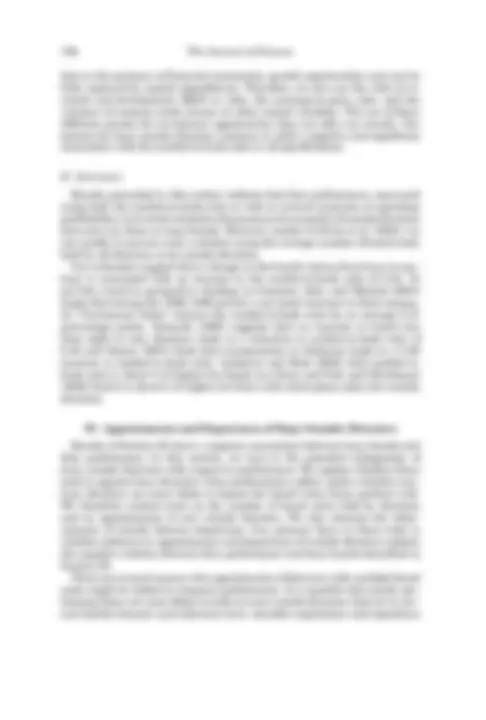
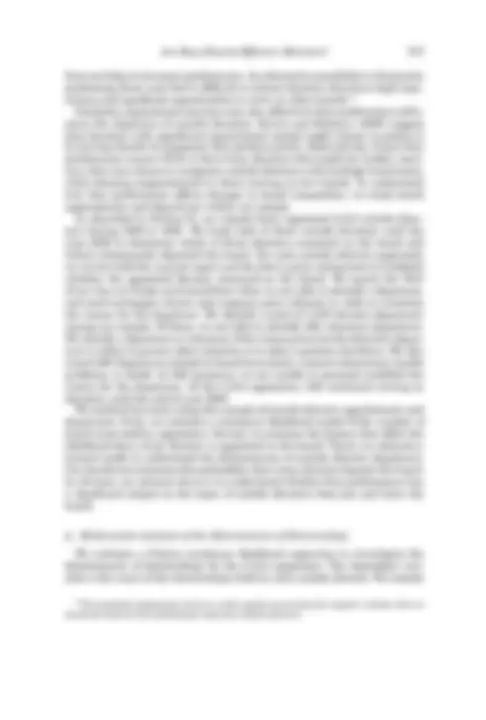

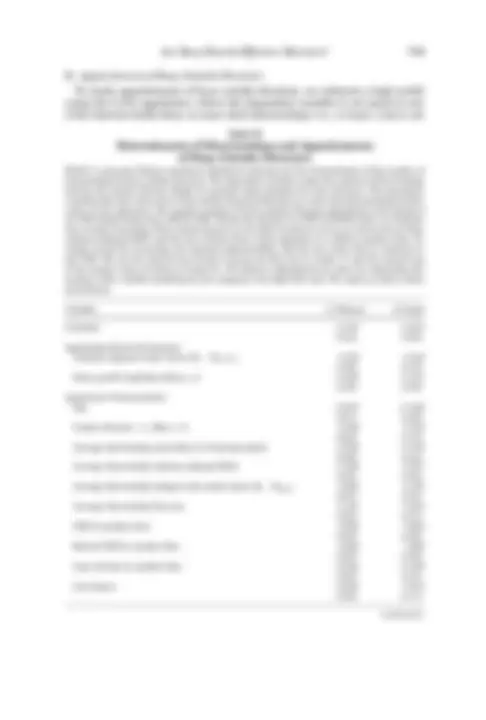
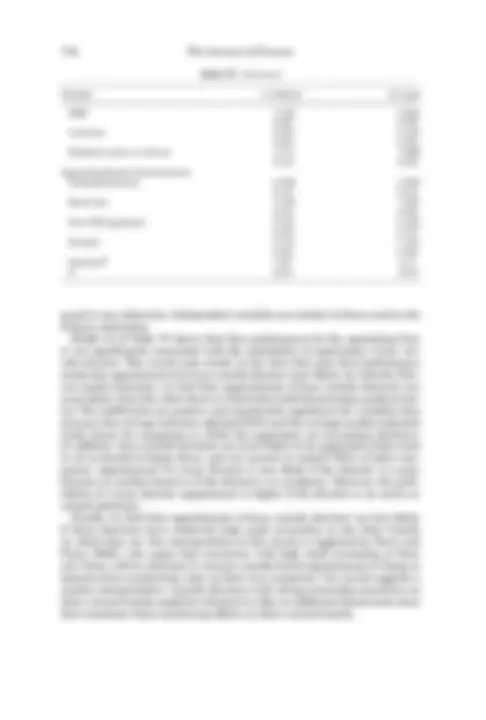
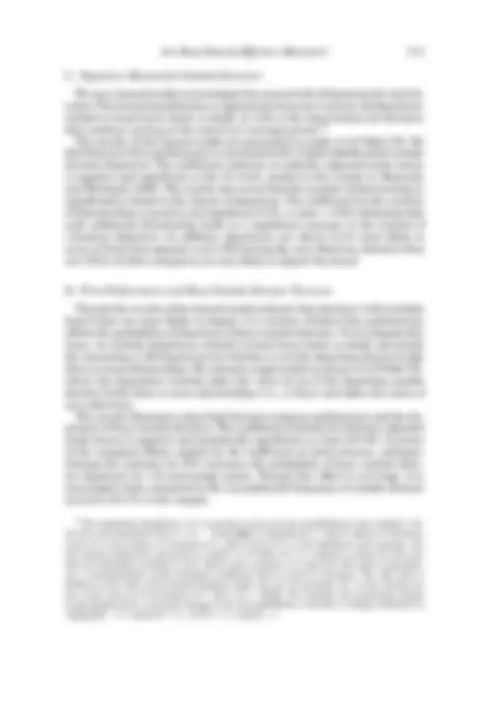
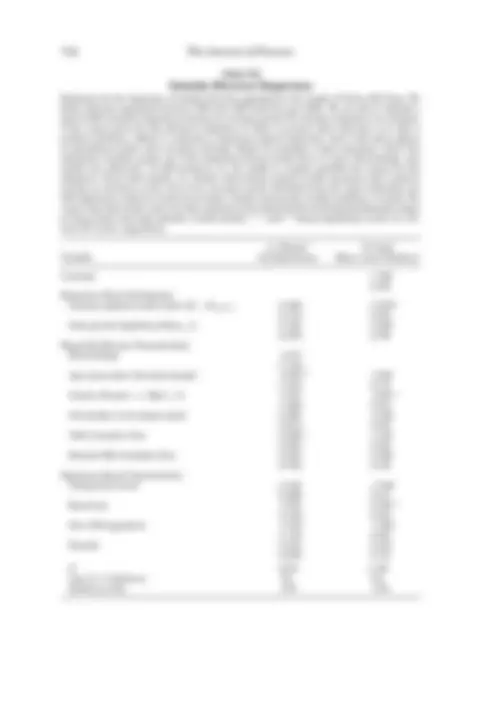
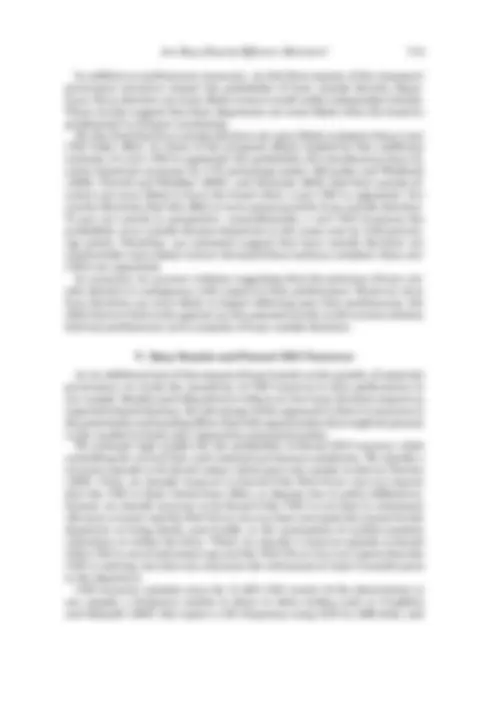
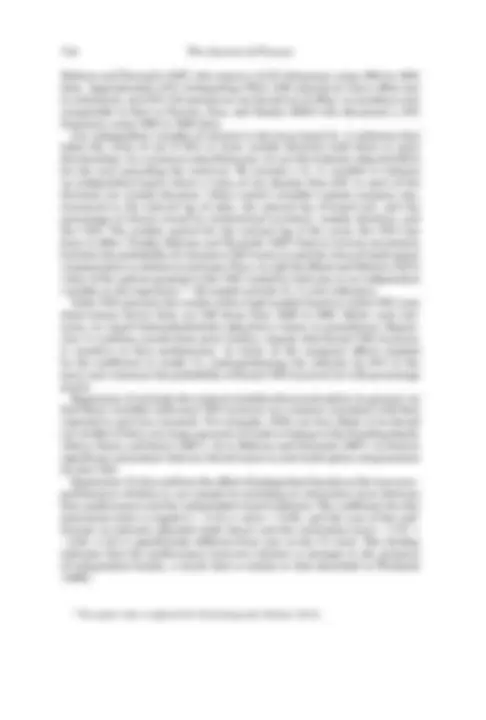
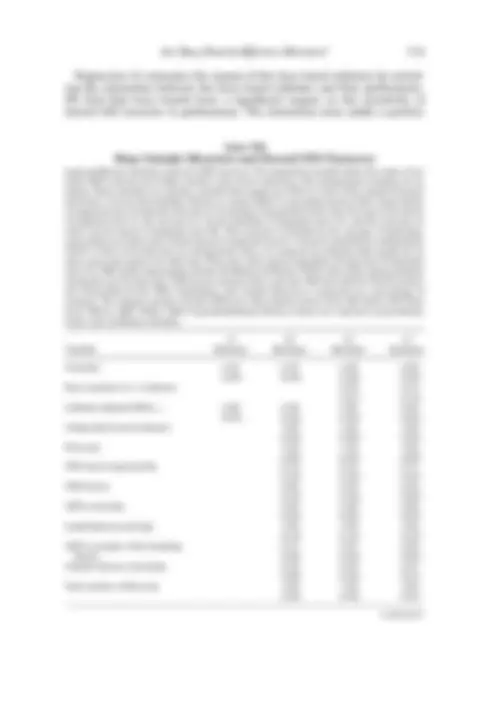

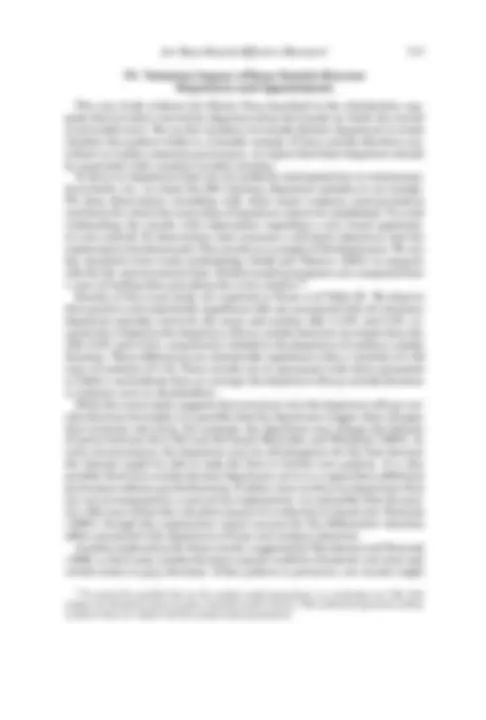
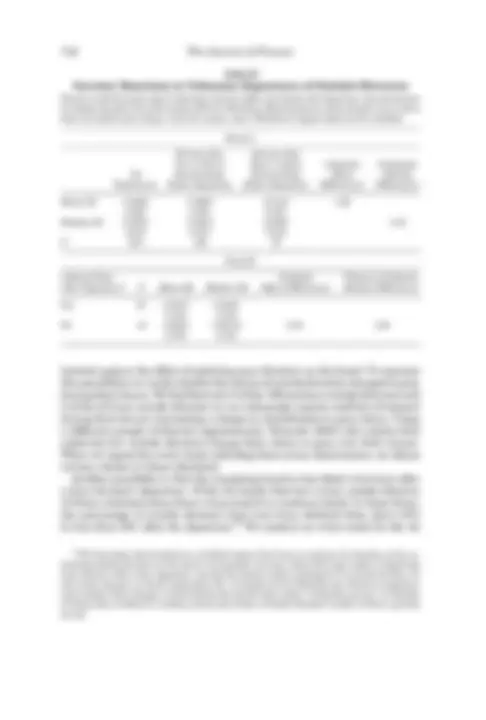

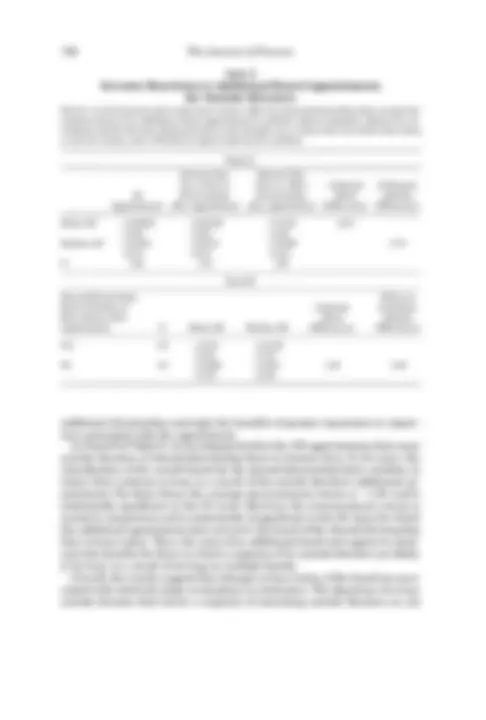
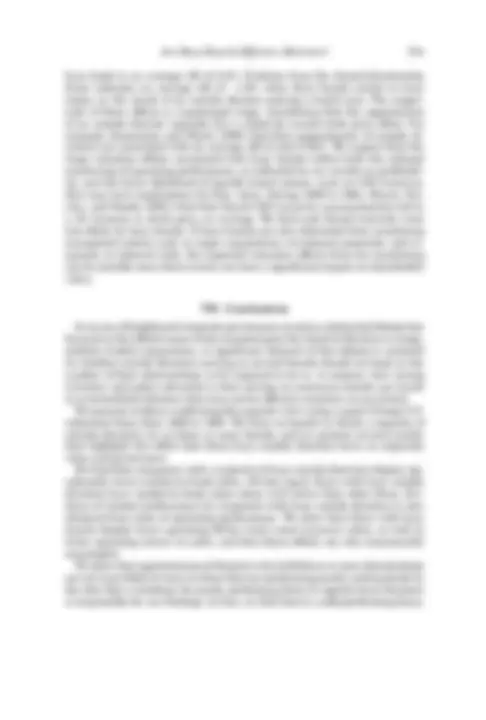





Study with the several resources on Docsity

Earn points by helping other students or get them with a premium plan


Prepare for your exams
Study with the several resources on Docsity

Earn points to download
Earn points by helping other students or get them with a premium plan
Community
Ask the community for help and clear up your study doubts
Discover the best universities in your country according to Docsity users
Free resources
Download our free guides on studying techniques, anxiety management strategies, and thesis advice from Docsity tutors
Material Type: Paper; Class: Theory of Corporate Finance; Subject: Finance; University: California State University - Fullerton; Term: Spring 2006;
Typology: Papers
1 / 36

This page cannot be seen from the preview
Don't miss anything!





























THE JOURNAL OF FINANCE •^ VOL. LXI, NO. 2 •^ APRIL 2006
Firms with busy boards, those in which a majority of outside directors hold three or more directorships, are associated with weak corporate governance. These firms ex- hibit lower market-to-book ratios, weaker profitability, and lower sensitivity of CEO turnover to firm performance. Independent but busy boards display CEO turnover- performance sensitivities indistinguishable from those of inside-dominated boards. Departures of busy outside directors generate positive abnormal returns (ARs). When directors become busy as a result of acquiring an additional directorship, other com- panies in which they hold board seats experience negative ARs. Busy outside directors are more likely to depart boards following poor performance.
∗Fich is with Drexel University and Shivdasani is with the University of North Carolina at
Chapel Hill. The paper benefited from comments by participants at the 2005 American Finance Association meetings, the 2004 Financial Research Association conference, and by seminar partic- ipants at Drexel, INSEAD, Seton Hall, North Carolina State, University of North Carolina, and Universidade Catolica de Portugal. The authors thank Anup Agrawal, Stuart Gillan, Bill Greene, Naveen Khanna, Robert Stambaugh, David Yermack, and an anonymous referee for helpful sugges- tions. The authors acknowledge financial support from the Wachovia Center for Corporate Finance. (^1) Cummings, Jeanne, and Greg Jaffe (2000), A floated name for cabinet lands with a thud, Wall
Street Journal , Eastern Edition, December 28, A12. (^2) Lublin, Joann S. (2001), Multiple seats of power—Companies are cracking down on number of
directorships board members can hold, Wall Street Journal , January 23, B1.
690 The Journal of Finance
Table I Investor Reaction to Elaine Chao’s Cabinet Nomination
Two-day cumulative abnormal returns (CARs) for the firms in which Elaine L. Chao served as an outside director. CARs are computed for all firms around December 28, 2000 (day “0”), the day when the Wall Street Journal first announced that Elaine L. Chao would join President-elect George W. Bush’s cabinet. The sample includes the following firms: C.R. Bard, Clorox, Columbia/HCA Healthcare, Dole Food, Northwest Airlines, and Protective Life. Following her confirmation as secretary of labor, Ms. Chao resigned her directorships in these firms. We report t -statistics and Wilcoxon rank Z- statistics using a two-tailed test for significance.
Mean Positive: Median Returns Days N Return t -Statistic Negative Return Wilcoxon Z
Raw return (− 1 +0) 6 5.24% 1.99 6:0 4.49% 2. Cumulative abnormal (− 1 +0) 6 3.80% 2.22 6:0 3.05% 1. return (CAR)
abnormal return (CAR) is 3.8% ( t- statistic = 2.2) and the median CAR is 3.05%
(Wilcoxon Z = 1.8). All six firms in the study elicit positive investor reactions at announcement. 3
While illustrative, this case study evidence is subject to a number of caveats.
Investors might expect the six firms, whose boards Ms. Chao vacated, to benefit
from her new political influence. Investors may also reassess the quality of the
remaining board members due to a “halo effect” surrounding her nomination.
Even if the stock price effect reflects the departure of a busy director, it is
likely that the magnitude of this effect is exaggerated due to her status as
one of America’s busiest directors. Nonetheless, the evidence is suggestive of a
negative impact of busy directors on firm value. Whether this effect holds in a
systematic fashion across a broad sample of firms is the focus of this paper.
There is a growing literature that shows that serving on multiple boards can
be a source of both valuable experience and reputational benefits for outside di-
rectors. Fama and Jensen (1983) note that reputational effects can be important
incentives for outside directors. However, there is comparatively little evidence
on the costs associated with serving on multiple boards, and the prior research
on this topic is inconclusive. Beasley (1996) reports that the probability of com-
mitting accounting fraud is positively related to the average number of direc-
torships held by outside directors. Core, Holthausen, and Larcker (1999) report
that busy directors set excessively high levels of CEO compensation, which
in turn leads to poor firm performance. In contrast, Ferris, Jagannathan, and
Pritchard (2003) find no relation between the average number of directorships
held by outside directors and the firm’s market-to-book ratio.
We extend this literature along several dimensions. We show that inferences on whether multiple board seats held by directors affect firm performance are
(^3) We check for whether other news events might explain the observed abnormal returns. How-
ever, a Lexis-Nexis search around the announcement date fails to uncover release of other signifi- cant corporate news.
692 The Journal of Finance
Therefore, the extent to which outside directors are busy appears to be an impor-
tant determinant of the effectiveness of outside-dominated boards in corporate
governance.
Another piece of evidence comes from analysis of announcements of outside
director departures in our broader sample. Similar to the case study evidence
for Ms. Chao, abnormal returns (ARs) related to departure announcements of busy outside directors are significantly positive. Indeed, these returns are sig-
nificantly higher than the ARs for departures of nonbusy outside directors. In
addition, the results also indicate that departures of busy outside directors are
viewed particularly favorably when a majority of the remaining outside direc-
tors on the board is not busy. Finally, we examine how stock prices respond
when an incumbent director acquires an additional board seat. We find that
when directors become busy as a result of obtaining a new board seat, stock
prices tend to drop for the firms in which they are incumbent directors. More-
over, we also find that the decrease in stock price tends to be greater for firms
in which the appointment causes the majority of the board’s outside directors
to be reclassified as busy.
Collectively, our results indicate that when a majority of outside directors
are busy, firm performance suffers. At the same time, substantial evidence
from prior studies suggests that the number of board seats held by directors is
related to their performance as monitors and is correlated to their reputational
capital. Ferris et al. (2003) find that the first appointment of a busy director to
a board is good news for shareholders, implying that the enhanced experience
or reputation of such directors is beneficial. However, our results suggest that
there is also a cost to holding numerous board seats. As the number of outside
directors sitting on multiple boards increases, boards are inclined to become
distracted and monitoring intensity is likely to suffer. Therefore, our results
imply that it may not be optimal for firms to select directors primarily based on the number of other boards they sit on, since this may lead to an overcommitted
board.
Our results should not be interpreted as endorsing the recent efforts of in-
stitutional investors and corporate governance policy advocates in curbing the
directorships held by outside directors for at least two reasons. First, there
is substantial evidence that outside directorships tend to be correlated with
a director’s reputational capital and that the market for outside directorships
provides an important source of incentives for outside directors to serve as
monitors. Therefore, attempts to limit the number of outside directorships may
reduce the strength of the incentives for some outside directors to engage in
effective corporate governance. Second, our results relate primarily to the costs
faced by firms that appoint busy outside directors—we are silent on the bene-
fits that appointing companies might obtain when their executives join other
boards as outside directors. Recent work by Perry and Peyer (2005) shows that
sending firms benefit when their executives receive additional directorships,
if measures of agency costs in these firms are relatively low. While our paper
points to the potential benefits of limiting the number of board seats held by
outside directors, policy recommendations on this issue should also incorporate
Are Busy Boards Effective Monitors? 693
the expected costs of curtailed director incentives and those borne by sending
firms.
Our paper proceeds as follows. Section I reviews the relevant literature and
formulates our research questions. Section II describes our sample. Section III
studies whether busy boards affect firm performance. Section IV details our
empirical tests on appointments and departures of outside directors. Section V investigates whether busy boards play a role during events of CEO turnover.
Section VI analyzes investor reactions related to the departure of busy outside
directors and also provides evidence on the impact of additional board seats on
firms in which the director serves as an incumbent outside director. Section VII
concludes.
I. Prior Literature on Directorships
Fama (1980) and Fama and Jensen (1983) argue that the market for outside
directorships serves as an important source of incentives for outside directors
to develop reputations as monitoring specialists. Mace (1986) suggests that out-
side directorships are perceived to be valuable because they provide executives
with prestige, visibility, and commercial contacts.
Support for the reputational capital view of directorships comes from sev-
eral studies which show that the number of boards that outside directors sit on is tied to the performance of the firms in which these directors are incum-
bents, either as CEOs or as outside directors. This pattern is documented for
financially distressed companies (Gilson (1990)), for firms that cut dividends
(Kaplan and Reishus (1990)) and opt out of stringent state antitakeover provi-
sions (Coles and Hoi (2003)), for companies that fire their CEOs (Farrell and
Whidbee (2000)), for firms that are sold (Harford (2003)), for CEOs following
retirement (Brickley, Linck, and Coles (1999)), as well as for broad samples of
firms (Yermack (2004)). Accordingly, several studies use the number of board
seats held by an outside director as a proxy for the director’s reputation in the
external labor market (Shivdasani (1993), Vafeas (1999), Brown and Maloney
(1999)).
While the number of directorships appears to be closely linked to di-
rectors’ reputational capital, other studies suggest that too many director-
ships may lower the effectiveness of outside directors as corporate monitors
(see, e.g., Core et al. (1999), Shivdasani and Yermack (1999)). Core et al.
(1999) find that busy outside directors provide CEOs with excessive compen-
sation packages, which in turn leads to weaker firm performance. Consis-
tent with such a view, the National Association of Corporate Directors and
the Council for Institutional Investors have adopted resolutions calling for
limits on the number of directorships held by directors of publicly traded
companies.^4
(^4) See the Report of the National Association of Corporate Directors Blue Ribbon Commission on
Director Professionalism (1996), and the Core Policies, Positions and Explanatory Notes from the Council of Institutional Investors (1998).
Are Busy Boards Effective Monitors? 695
In sum, there is substantial evidence supporting the view that outside di-
rectorships serve as a measure of a director’s reputational capital. However,
there is disagreement on whether sitting on numerous boards detracts from
the ability of outside directors to perform as effective monitors. Our tests
are designed to address the question of whether directors that serve on nu-
merous boards tend to contribute to weaker corporate governance at these firms.
II. Sample and Data
A. Sample Selection
Our sample consists of firms that appear in the 1992 Forbes 500 lists of largest
corporations based on assets, sales, market capitalization, or net income during
the 7-year period from 1989 to 1995. We impose three screening criteria. First,
we require that each company in the sample has at least 2 consecutive years
of financial data available from the Center for Research in Security Prices
and from Compustat. Second, relevant Securities and Exchange Commission
filings have to be available on the Edgar data retrieval system. Third, utility
and financial companies are excluded from the sample since regulatory effects
may lead to a more limited role for their boards of directors. These criteria
yield a final sample of 3,366 observations for 508 industrial companies across
the 7 years.
For each firm, we collect data on corporate governance variables from proxy
statements filed for each company during the sample period. Each director is
classified according to his/her principal occupation. Full-time employees of the
firm are designated as insiders. Directors associated with the company, former
employees, those with existing family or commercial ties with the firm other
than their directorship, or those with interlocking directorships with the CEO
are designated as “gray.” Directors that do not fit the description for inside or
gray directors are classified as outside directors. We categorize boards as being interlocked if the CEO sits on the board of an outside director.
Descriptive statistics for key variables for the 508 companies are presented
in Panel A of Table II. On average, outside directors hold 3.11 directorships (the
median is 2.89). We count directorships held in all publicly traded firms but do
not consider directorships held in nonpublic firms, not-for-profit and charitable
organizations, trusts, and associations.
We consider outside directors busy if they serve on three or more boards. Al-
though the three-directorship criterion is admittedly somewhat arbitrary, we
choose this cutoff for several reasons. First, the mean and median number of
directorships in the sample is close to three, resulting in a roughly even split
between busy and nonbusy outside directors. Second, it reflects the recommen-
dation by the Council for Institutional Investors that directors should sit on no
more than two boards. Finally, our definition is consistent with prior work by
Core et al. (1999) and Ferris et al. (2003) who also use the three-directorship
benchmark for classifying executives as busy.
696 The Journal of Finance
Using this definition, 52% of the outside directors in the sample are classified
as busy. Perry and Peyer (2005) report a comparable frequency of busy outside
directors in their sample. To measure the prevalence of busy outside directors
on the board, we construct a (0, 1) indicator that takes the value of one if 50% or
Table II Data Description
Panel A provides descriptive statistics for characteristics of our sample firms. The sample consists of 3,366 annual observations for 508 companies between 1989 and 1995. Companies are included in the sample if they are listed by Forbes magazine as one of the largest U.S. public corporations in its 1992 survey of the 500 largest U.S. public companies in any of the categories of market capital- ization, sales, net income, or assets. The sample excludes private, utility, and financial companies. The table presents the mean, median, and SD for each variable, as well as the Spearman sample correlation coefficient between all variables and a (0, 1) indicator that equals one if is the board is defined as busy, which occurs when 50% or more of the board’s outside directors hold three or more directorships. ∗, ∗∗, and ∗∗∗^ denote statistical significance at the 1%, 5%, and 10% levels, respectively. Panel B shows characteristics of 2,314 outside directors appointed to the boards of our sample firms from 1989 to 1995. Outside directors are those that are not current or former employees of the firm, are not relatives of the CEO, have no business deals with the firm other than their directorship, and do not have interlocking directorships with the CEO. We classify boards as being interlocked if the CEO sits on the board of an outside director. Data on director characteristics are obtained from annual proxy statements.
Panel A
Correlation with Variable Mean Median SD “Busy Board”
Board Characteristics Directorships per outside director 3. 11 2. 89 2. 23 0. 22 ∗ Percentage of inside directors 29. 67 26. 05 15. 03 − 0. 07 ∗∗∗ Percentage of gray directors 15. 02 9. 21 13. 32 − 0. 12 ∗∗∗ Percentage of outside directors 55. 33 56. 23 17. 12 0. 68 ∗ Percentage of directors who are 14. 96 13. 20 11. 70 0. 56 ∗ other firms’ CEOs Percentage of busy directors 52. 26 – – – Percentage of busy boards 21. 42 – – – Board size 11. 88 12 2. 95 0. 15 ∗ Presence of interlocked board 0. 36 0 0. 72 0. 48 ∗∗ Directors’ fees (1995 dollars) 35,904 27,601 13,562 0. 29 ∗ Number of board meetings/year 7. 56 7 2. 56 0. 31 ∗ Governance Structure CEO from founding family (0, 1) 0. 26 0 0. 39 − 0. 28 ∗∗∗ Non-CEO chairman of board (0, 1) 0. 15 0 0. 33 − 0. 08 ∗∗∗ CEO’s tenure as CEO 8. 68 7. 5 7. 68 0. 12 ∗∗ CEO’s age 58. 06 56 7. 04 0. 00 Insider ownership (% common) 6. 97 2. 22 13. 67 − 0. 21 ∗∗ Institutional ownership (% common) 49. 13 33. 33 13. 92 − 0. 06 ∗ Firm Characteristic s Total sales (1995 $MM) 9,016.01 3,444.72 21,100.23 0. 31 ∗ EBIT/Total assets 0. 191 0. 150 0. 128 0. 10 ∗ Firm age (years since incorporation) 23. 6 12 9. 33 0. 45 ∗
( continued )
698 The Journal of Finance
B. Average Directorships versus Busy Boards
Understanding what constitutes a busy board is a central issue underlying
our tests. We consider boards busy if 50% or more of the outside directors hold
three or more board seats instead of using the average number of directorships
by outside directors to identify busy boards. At issue is the extreme skewness in the distribution of board seats held by outside directors. An example is helpful
in illustrating this measurement issue.
Panels A through D of Table III report board appointments held by outside
directors at Host Marriott, Gannett Newspapers, The Clorox Company, and
MGM Grand, Inc., as disclosed in their 1993 proxy statements. While the ratio
of total directorships to outside directors for Host Marriott and Gannett News-
papers is similar, 3.5 and 3.4, respectively, we determine that Host Marriott has
a busy board, but not Gannett Newspapers. Conversely, a comparison of MGM
Grand and Clorox demonstrates that a high average number of directorships
does not necessarily indicate that a majority of outside directors are busy. The
average ratio of directorships by outside directors is 3.66 for MGM Grand and
only 2.66 for Clorox. However, 50% of the outside directors at Clorox are busy
as compared to only 33% at MGM.
Panel E of Table III shows that a one-to-one correspondence between the
average number of directorships and busy boards also fails to hold in the full
sample. We divide the sample into four groups based on the percentage of out-
side directors that are classified as busy. When more than 75% of the outside
directors are busy, the average number of directorships per outside director is
3.35. However, when only 25–50% of the outside directors are busy, the average
number of directorships held by outside directors is 3.41. Our measurement
treats boards in the first group as busy, while Ferris et al. (2003) would treat
firms in the second group as having busier boards. As we illustrate later, our
measurement appears to highlight a stronger link between busy boards and firm performance than using the average number of board seats variable.
III. Busy Boards and Firm Performance
Our first set of tests involves panel data estimates relating the market-to-
book ratio to busy boards and other corporate governance and financial at-
tributes. These models assume that a high market-to-book ratio is indicative
of good management and governance. However, alternative interpretations of
a high market-to-book ratio are equally plausible. In particular, if financial or
liquidity constraints cause some firms to underinvest, the potential value of
unexploited investments may lead to a high marginal Tobin’s Q. If underin-
vestment is pervasive, our formulation would erroneously treat a high market-
to-book ratio as indicative of good governance. We address this issue by using
a number of controls for investment opportunities. However, we recognize that
all measures are subject to measurement error. Therefore, we also supplement
the market-to-book ratio tests with similar models estimating operating perfor-
mance. Since historical operating performance does not employ market prices,
Are Busy Boards Effective Monitors? 699
Table III Directorships by Outside Directors
Panels A through D report the total number of directorships held by outside directors, the mean directorships per outside director, and the percentage of outside directors holding three or more directorships for four companies in our data set during the 1993 proxy season. The total number of directorships simply counts the number of total boards of publicly traded firms on which the outside director serves. We do not count board service in private firms, charitable institutions, or not-for-profit organizations. The last row in each panel provides a (0, 1) variable for whether boards are busy. We code boards as busy, with a one, if 50% or more outside directors hold three or more total directorships. Panel E reports mean directorships per outside director and per board for our sample firms according to the percentage of outside directors holding three or more directorships. Directorships per outside director are estimated as the total directorships held by outside directors divided by the number of outside directors. Similarly, directorships per board are all directorships held by every director, regardless of his/her classification, divided by board size.
Director Main Occupation Total Directorships
Panel A: Host Marriott—Outside Directors 1993
R. T. Ammon Former Partner, Kohlberg Kravis Roberts & Co. 4 A. D. McLaughlin President, Federal City Council (former U.S. secretary of labor)
H. L. Vincent, Jr. Retired Vice-Chairman, Booz-Allen & Hamilton 1 A. J. Young Vice Chairman, Law Companies Group, Inc. 1 Total directorships 14 Total directorships/outside directors 14/4 = 3. Percentage with three or more directorships 50% Is the board busy? (0 = No, 1 = Yes) Yes
Panel B: Gannett Newspapers—Outside Directors 1993
Rosalyn Carter Former First Lady of the United States of America 1 C. T. Rowan President, CTR Productions 2 D. D. Wharton CEO, Fund for Corporate Initiatives 3 A. F. Brimmer Retired officer, Federal Reserve Bank 9 M. A. Brokaw Owner, Penny Whistle Toys 2 Total directorships 17 Total directorships/outside directors 17/5 = 3. Percentage with three or more directorships 40% Is the board busy? (0 = No, 1 = Yes) No
Panel C: Clorox—Outside Directors 1993
D. Boggan Vice Chancellor, U.C. Berkeley 1 D. O. Morton Retired COO, Hewlett Packard 5 E. L. Scarff Former CEO, Arcata Corporation 1 L. R. Scott CEO, Carolina Freight 3 F. N. Shumway Retired Chairman, Allied Signal 4 J. A. Vohs Retired Chairman, Kaiser Health GP 2 Total directorships 16 Total directorships/outside directors 16/6 = 2. Percentage with three or more directorships 50% Is the board busy? (0 = No, 1 = Yes) Yes ( continued )
Are Busy Boards Effective Monitors? 701
variables (Vafeas (1999)). We control for both the presence of interlocking di-
rectorships between outside directors and the CEO using an indicator variable,
and for the number of outside directorships held by the CEO (Booth and Deli
(1996)). Our regressions include the ratio of depreciation expenditures to sales
as a measure of the firm’s investment opportunity set (tests using alternative
measures are described later), and also control for firm age. Throughout, the fixed effects specification is employed to control for unobservable attributes,
such as company’s history, culture, and product mix, that potentially affect
firm performance.
The results of the multivariate models are reported in Table IV. Model (1)
shows that the coefficient for the busy board indicator is negative and statisti-
cally significant at the 1% level. In model (2), we use the percentage of outside
directors that are busy and find a negative and significant coefficient on this
variable as well. Therefore, both specifications indicate a negative and statis-
tically significant relation between the presence of busy outside directors and
the market-to-book ratio. Our estimates suggest that the impact of busy out-
side directors on firm performance is economically nontrivial. The coefficient
estimate in model (1) indicates that a busy board reduces the market-to-book
ratio by about 0.04.
We examine if the marginal impact of a busy outside director depends on
whether or not a majority of the outside directors are busy. Model (3) includes
an interaction term between the percentage of busy outside directors and the
busy board indicator variable. The interaction term is negative and significant
at the 6% level, indicating that when a majority of outside directors are busy, the
market-to-book ratio has a stronger negative association with the percentage of
busy outside directors. This suggests that reducing the fraction of busy directors
for boards in which a majority of outside directors are busy is likely to yield
more meaningful valuation improvements. Coefficient estimates for the control variables are in line with those reported
by other studies. We obtain an inverse and statistically significant association
between board size and firm performance (Yermack (1996)). The number of busi-
ness segments is negatively related to performance (Berger and Ofek (1995)),
while ownership by officers and directors yields positive coefficients (Yermack
(1996)). As in Fich and Shivdasani (2005), we find that firm size is positively
associated with market-to-book ratio. Market-to-book ratios are also negatively
related to firm age and the presence of an interlocking board, though the latter
effect is significant at the 10% level in some specifications.
Using the fixed effects framework, we are able to replicate the cross-sectional
results of Ferris et al. (2003) in our sample. Ferris et al. (2003) measure the de-
gree to which directors are busy by using the average numbers of directorships
per director and directorships per outside director. Models (4) and (5) show
that neither of these two variables displays a significant association with the
market-to-book ratio; similar to the results obtained by Ferris et al. (2003). The
contrast between these results and those shown in models (1)–(3) suggest that
inferences on the effects of busy boards are sensitive to how the presence of
busy directors is measured.
702 The Journal of Finance
Table IV
This table presents fixed effects regressions of firm performance and busy outside directors. All regressions use market-to-book ratio as the dependent variable. We calculate the market-to-book ratio as the market value of the firm’s equity at the end of the year plus the difference between the book value of the firm’s assets and the book value of the firm’s equity at the end of the year, divided by the book value of the firm’s assets at the end of the year. This calculation closely follows that of Smith and Watts (1992). Regression (1) uses a (0, 1) dummy variable equal to one if 50% or more of the board’s outside directors individually hold three or more directorships as the key independent variable. Regression (2) uses the percentage of outside directors that hold three or more directorships (i.e., are busy) as the key independent variable. We classify boards as being interlocked if the CEO sits on the board of an outside director; all other variables are self-explanatory or are described in the main text. The sample is described in Panel A of Table II. We report White (1980) heteroskedasticity-robust p -values in parentheses below each coefficient estimate.
Variable (1) (2) (3) (4) (5)
Board Characteristics Average directorships by outside directors − 0. 077 (0.26) Average directorships by board − 0. 040 (0.60) Busy outside directors (0, 1) − 0. 042 (0.00) Percentage of busy outside directors − 0. 152 − 0. 083 (0.00) (0.00) Percentage of busy outside directors × Busy − 0. 071 outside directors (0, 1) (0.06) Log of the directorships held by the CEO − 0. 166 − 0. 169 − 0. 160 − 0. 179 − 0. 177 (0.16) (0.13) (0.13) (0.09) (0.12) Firm has an industry director 0. 050 0. 049 0. 044 0. 048 0. 049 (0.28) (0.54) (0.60) (0.32) (0.23) Directors’ ownership (% of common) 0. 187 0. 122 0. 124 0. 188 0. 188 (0.09) (0.08) (0.07) (0.10) (0.08) Board interlock (0, 1) − 0. 009 − 0. 008 − 0. 008 − 0. 014 − 0. 010 (0.07) (0.07) (0.08) (0.05) (0.05) CEO ownership (% of common) 0. 008 0. 015 0. 016 0. 009 0. 009 (0.12) (0.08) (0.09) (0.13) (0.13) Log of board size − 0. 314 − 0. 290 − 0. 298 − 0. 303 − 0. 299 (0.01) (0.05) (0.05) (0.01) (0.05) Log of board meetings − 0. 091 − 0. 119 − 0. 100 − 0. 093 − 0. 090 (0.26) (0.40) (0.27) (0.22) (0.29) Board committees − 0. 016 − 0. 013 − 0. 009 − 0. 011 − 0. 015 (0.68) (0.58) (0.47) (0.56) (0.64) Board composition (% outside directors) 0. 165 0. 147 0. 149 0. 161 0. 161 (0.06) (0.24) (0.20) (0.06) (0.06) Firm Characteristics Return on assets 2. 002 2. 044 2. 029 1. 996 2. 004 (0.00) (0.01) (0.00) (0.00) (0.00) Firm size (log of total sales) 0. 433 0. 436 0. 441 0. 430 0. 438 (0.00) (0.00) (0.00) (0.00) (0.00) Firm age − 0. 001 − 0. 001 − 0. 001 − 0. 001 − 0. 001 (0.01) (0.01) (0.01) (0.01) (0.01) Growth opportunities 0. 077 0. 093 0. 080 0. 100 0. 079 (depreciation expense/sales) (0.24) (0.27) (0.25) (0.31) (0.26) Number of business segments − 0. 049 − 0. 051 − 0. 048 − 0. 052 − 0. 049 (0.00) (0.00) (0.00) (0.00) (0.00) Year (0, 1) indicators Yes Yes Yes Yes Yes Adjusted R^2 37.53% 37.69% 38.11% 33.02% 34.18%
704 The Journal of Finance
Table V
In this table, the dependent variables are return on assets (ROA), sales over assets, and return on sales. We first sum operating income before depreciation (Compustat item 13) plus the decrease in receivables (Compustat item 2), the decrease in inventory (Compustat item 3), the increase in current liabilities (Compustat item 72), and the decrease in other current assets (Compustat item 68). We scale this measure by the average of beginning- and ending-year book value of total assets (Compustat item 6) to find ROA. Similarly, we divide this measure by the average of beginning- and ending-year sales to compute ROS. We use the log of total capital as a proxy for firm size. Regressions (1), (2), and (3) use a (0, 1) dummy variable that equals one if 50% or more of the board’s outside directors individually hold three or more directorships as the key independent variable. Regression (2) uses the percentage of outside directors that hold three or more directorships (i.e., are busy) as the key independent variable. All other variables are self-explanatory or are described in the main text. The sample consists of Forbes 500 firms from 1989 to 1995 described in Panel A of Table II. White (1980) heteroskedasticity-robust p -values appear in parentheses below each coefficient estimate.
Dependent Variable
(1) (2) (3) (4) Independent Variables ROA ROA Sales/Assets ROS
Board Characteristics Busy outside directors (0, 1) − 0. 00235 − 0. 033 − 0. 00272 (0.00) (0.02) (0.00) Percentage of busy outside directors − 0. 0163 (0.01) Log of the directorships held by the CEO − 0. 078 − 0. 071 − 0. 002 − 0. 041 (0.27) (0.20) (0.61) (0.33) Firm has an industry director 0. 020 0. 015 0. 004 0. 018 (0.31) (0.33) (0.40) (0.39) Directors’ ownership (% of common) 0. 022 0. 025 0. 222 0. 024 (0.17) (0.11) (0.09) (0.11) Board interlock (0, 1) − 0. 005 − 0. 005 − 0. 004 − 0. 005 (0.10) (0.13) (0.06) (0.08) CEO ownership (% of common) 0. 003 0. 003 0. 141 0. 005 (0.17) (0.29) (0.29) (0.13) Log of board size − 0. 041 − 0. 043 − 0. 139 − 0. 032 (0.01) (0.01) (0.04) (0.01) Log of board meetings − 0. 129 − 0. 134 − 0. 099 − 0. 138 (0.05) (0.06) (0.11) (0.02) Board committees − 0. 000 − 0. 000 − 0. 005 − 0. 000 (0.40) (0.42) (0.44) (0.39) Board composition (% outside directors) 0. 002 0. 002 0. 003 0. 007 (0.35) (0.38) (0.45) (0.11) Firm Characteristics Return on sales (1) and (2), 1. 841 1. 967 3. 671 4. 698 Return on capital (3) and (4) (0.00) (0.00) (0.00) (0.00) Firm size 0. 048 0. 047 0. 166 0. 094 (0.00) (0.00) (0.01) (0.03) Firm age − 0. 0008 − 0. 0008 − 0. 0006 − 0. 0008 (0.03) (0.04) (0.14) (0.03) Depreciation expense/sales 0. 054 0. 050 0. 063 0. 060 (0.06) (0.05) (0.07) (0.13) Number of business segments − 0. 006 − 0. 006 − 0. 003 − 0. 008 (0.05) (0.04) (0.00) (0.03) Year (0, 1) indicators Yes Yes Yes Yes Adjusted R^2 26.36% 27.10% 13.90% 25.01%
Are Busy Boards Effective Monitors? 705
indicator and other corporate governance variables. These tests continue to
yield an inverse and statistically significant association between firm perfor-
mance and our busy board measures. We describe more detailed tests of this
potential endogeneity in Section IV.
C.2. Size and Performance Proxies
We repeat the analyses presented in Table IV using different proxies for firm
size, replacing the natural log of sales by both the natural log of capital and
the natural log of assets. 7 These tests also yield an inverse association between
busy board and performance. Our result continues to be robust to different con-
structions of the dependent variable. Instead of the Smith and Watts (1992)
market-to-book ratio calculation, we use the Tobin’s Q calculation of Perfect
and Wiles (1994), and the Q calculation of Shin and Stulz (2000). These dif-
ferent constructions of the dependent variable do not qualitatively alter the
results.
C.3. Characterizing Busy Outsiders
We use a less expansive definition of our key independent variable based
on a slightly different procedure to identify busy outside directors. Core et
al. (1999) differentiate between outside directors that are currently employed
and those that are retired. In their taxonomy, retired outside directors are
considered busy if they serve on six or more publicly traded boards. We fol-
low their definition and deem employed outside directors busy when they hold
three or more directorships and retired outside directors busy when they hold
six or more directorships. A board is defined as busy when 50% or more of
its outside directors are individually classified as busy. We construct a (0,
Table IV. The coefficient estimate for a (0, 1) independent variable under this
taxonomy is −0.0401 ( p- value = 0.06). This estimate is slightly smaller in
magnitude than that reported in Table IV, but generates qualitatively similar
inferences.
C.4. Investment Opportunities
Notwithstanding the results in Table V, a concern with the regressions pre-
sented in Table IV is whether we appropriately control for the role of the firm’s
investment opportunity set. As an alternative to using depreciation to control
for investment opportunities, we use the ratio of capital expenditures to sales
and obtain results similar to those reported earlier. We recognize the possibility
(^7) Total capital adds the market value of the firm’s equity, book value, long-term debt, and an
estimated market value of preferred stock. We calculate the market value of preferred stock by dividing preferred dividends over the prevailing yield on Moody’s index of high-grade industrial preferred stocks.
Are Busy Boards Effective Monitors? 707
that can help reverse poor performance. An alternative possibility is that poorly
performing firms may find it difficult to attract directors that have high repu-
tations and significant opportunities to serve on other boards. 8
Similarly, reputational concerns may also affect how firm performance influ-
ences the departure of outside directors. Brown and Maloney (1999) suggest
that directors with significant reputational capital might choose to protect it by leaving boards of companies that perform poorly. Alternatively, if poor firm
performance causes CEOs to favor busy directors that might be weaker moni-
tors, they may choose to reappoint outside directors with multiple board seats,
while denying reappointment to those serving on few boards. To understand
how firm performance affects changes in board composition, we study board
appointments and departures within our sample.
As described in Section II, our sample firms appointed 2,314 outside direc-
tors during 1989 to 1995. We track each of these outside directors until the
year 2000 to determine which of these directors remained on the board and
which subsequently departed the board. For each outside director appointed,
we review both the annual report and the firm’s proxy statements to establish
whether the appointed director remained on the board. We search the Wall
Street Journal Index and Lexis/Nexis when we are able to identify a departure,
and read newspaper stories and company press releases in order to ascertain
the reason for the departure. We identify a total of 1,676 director departures
among our sample. Of these, we are able to identify 360 voluntary departures.
We classify a departure as voluntary if the reason given for the director’s depar-
ture is either to pursue other interests or to take a position elsewhere. We also
record 490 departures related to board term limits, normal retirements, health
problems, or death. In 826 instances, we are unable to precisely establish the
reason for the departure. Of the 2,314 appointees, 638 continued serving as
directors until the end of year 2000. We conduct four tests using this sample of outside director appointments and
departures. First, we estimate a maximum likelihood model of the number of
board seats held by appointees. Second, we examine the factors that affect the
likelihood that a busy director is appointed to the board. Third, we estimate a
hazard model to understand the determinants of outside director departures.
Our fourth test examines the probability that a busy director departs the board.
In all tests, our primary focus is to understand whether firm performance has
a significant impact on the types of outside directors that join and leave the
board.
A. Multivariate Analysis of the Determinants of Directorships
We estimate a Poisson maximum likelihood regression to investigate the
determinants of directorships for the 2,314 appointees. The dependent vari-
able is the count of the directorships held by each outside director. We include
(^8) This potential endogeneity, however, works against uncovering the negative relation that we
document between firm performance and busy outside directors.
708 The Journal of Finance
the industry-adjusted stock return over the prior year as a measure of the
appointing firm’s performance as an independent variable. The regression in-
cludes appointee-specific characteristics such as age, gender, and educational
and professional qualifications. We also include firm-specific attributes relat-
ing to the companies in which the individual serves as a director. Unless the
appointee is the CEO of another firm, we compute the average stock ownership by the outside director for all of the boards on which he/she serves, as well
as the average industry-adjusted ROA, the market-adjusted stock return, and
the average size (natural log of sales) of these firms. If the appointee is a CEO
in another firm, we record the stock ownership, industry-adjusted ROA, the
market-adjusted stock return, and the size of the firm in which he/she serves
as CEO.
The results of the Poisson model are reported in the first column of
Table VI. 9 We find that the performance of the appointing firm is unrelated to
the count of directorships held by outside director appointees. In contrast, the
average performance of the firms on whose boards the directors sit is positively
associated with their directorship count. The coefficients on both the average
directorship industry-adjusted ROA and the market-adjusted stock return are
positive, with p- values of 0.03 and 0.07, respectively.
We also observe that being a current or retired CEO of another firm pos-
itively affects the number of directorships held as does being a director at
larger companies. Similar results are documented in Fich (2005) and Ferris
et al. (2003) and suggest that the increased visibility from sitting on boards of
large companies may help some directors obtain more directorships. Finally,
we find a lower count of directorships when directors have gray status at other
boards, suggesting that firms avoid appointing board members that face poten-
tial conflicts of interest at other companies. Alternatively, extensive business
dealings with a firm may leave gray directors with little time to serve on other boards.
Overall, the results of the Poisson model indicate that the accumulation of
directorships is positively related to the performance of the firms in which
the individual is an outside director, but we do not find evidence that poor
performance increases the frequency of appointments of outside directors that
serve on several boards.
(^9) The Poisson model specifies that if λ is defined by log (λ) = X β, where X is a vector of indepen-
dent variables and β is a parameter vector, then the probability of n outside directors obtaining a directorship in a given year is given by: λ n^ e−λ/λ! The log-likelihood function of this specification is maximized over β to produce maximum likelihood estimates and is given as,
L (β) =
i = 1
t = 1
C 1 − e ( X it^ β)^ + nit X it β
where C 1 is a constant that does not change the maximization process, N is the number of firms, T is the number of time periods per firm, and nit is the number of outside directors obtaining a directorship in firm i in year t.